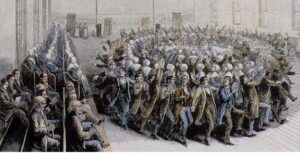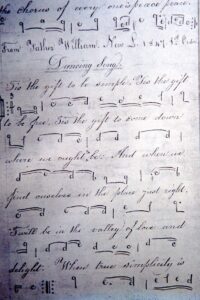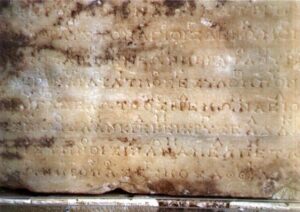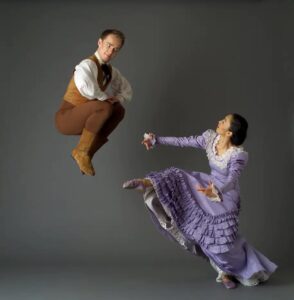
It seems a little unfair that the word “Shakers” nowadays calls up only a furniture style and, probably, the tune “Simple Gifts,” when this religious group had such a long and fascinating history. Honestly, the Wikipedia article about them is well worth a read if you’re at all interested in early American history and/or revivalist religious movements.
I’m going to get into Shaker music, but I do need to explain their beliefs and practices a bit in order to do so. This sect, which got its start in Britain around 1750, was a fascinating mixture of strict rules on the one hand and ecstatic outbursts on the other. Absolute celibacy was required for full membership; the sexes were housed separately and could not even shake hands or pass one another on the stairs. (I’m assuming the latter rule was in place because the staircases were so narrow.) They also lived communally and were strict pacifists. Yet their worship services were a mixture of music, dancing, and manifestations of spirituality that included twitching, jerking, and shouting, usually in some type of unknown language. (Those outward physical actions gave the group their name; originally they were called the “Shaking Quakers” and were an offshoot of the original Quakers.) They had to let off steam somehow, I guess. In spite of all the kerfuffle, though, the music itself was very plain, with no musical instruments used for accompaniment and no harmonies, just the melody. You can do a lot with a little; as our friend Wikipedia says:
Many melodies are of extraordinary grace and beauty, and the Shaker song repertoire, though still relatively little known, is an important part of the American cultural heritage and of world religious music in general.
Pre-Civil-War Shaker music doesn’t use conventional music notation but instead something called “letteral” style, in which the notes are indicated by letters, with markings over them to indicate timing. We have some examples of ancient Greek music that looks very much like this style of notation, interestingly enough. Here’s “Simple Gifts” written this way:

And I just couldn’t resist including a photo of an ancient Greek inscription from Delphi with a hymn to Apollo using the same style of notation—be sure to read the caption for an explanation of the markings:

You can refer back to my post on “Hark I Hear the Harps Eternal” in which I discuss another type of non-conventional notation, shape-note music, to find a discussion of how this type of system works. There are no absolute pitches; someone has to “start off” the tune at a reasonable pitch and then the tune can be sung by following the intervals. It sounds very difficult! But if you don’t have musical instruments you have no other way to establish pitch.
Post-Civil-War Shaker music is written with conventional notation and four-part harmonies, but most historians say that it lacks the striking originality of their earlier works. “Simple Gifts,” the most familiar Shaker melody today, is one of those early songs, having been composed in 1848 by a member of the Shaker community, Joseph Brackett. Nowadays, many contemporary Christian hymnals include the song; they of course use conventional notation. And they typically use a different set of lyrics, too, the “Lord of the Dance” text written in 1963 by someone named Sydney Carter, which uses dance as a metaphor for Jesus’ ministry on earth. I have to say that I love this song and find its words to be both witty and wise—I’ll restrain myself here and just include one quatrain:
I danced on a Friday
When the sky turned black
It’s hard to dance
With the devil on your back.
Later the tune was borrowed by Michael Flatley, the genius behind Riverdance and Lord of the Dance, who took Jesus out of the song and replaced him with a female pagan spirit. This borrowing has confused many about the origins of the song, but Randy Folger, a Shaker historian and re-enactor, says that “I’ve had people argue that this is really an old English or Irish folk tune. But I’ve done a lot of research into this, and the Shaker tune definitely came first.” (Complicated Life of “Simple Gifts”) I can’t resist pointing out here that Flatley was born in Chicago, not Ireland.
I’ll add as a small sidenote that the Christian churches who sing the tune, whether they’re using the “Simple Gifts” words or (more likely) the “Lord of the Dance” words, almost certainly have no clue just how heretical original Shaker teachings were. Mother Ann Lee, who led the band of Shakers from England to America in the mid-1770’s, claimed to be the female embodiment of Christ, fulfilling the scriptural promise of the Second Coming. Since this event had now taken place, the Shakers believed that they were living in what is usually called the Millennium, a 1,000-year period under the direct rule of God and his followers. So as they built their communities, worked at their handicrafts, wrote their music, and participated in their worship services, they believed that they were living out the reality of this kingdom. And they were an astonishingly-hardworking group, earning the respect of their neighbors by their strict ethics in business dealings and their inventiveness. One could imagine that there were some who might have liked to join them but who found celibacy to be too much of a bar. It won’t surprise any readers to find out that as of 2019 there were only three Shakers left.
It’s estimated that the Shakers composed over 12,000 songs. Why and how, then, did this one piece become so popular and well known while most of the others have vanished from sight? It all has to do with Aaron Copland: “The song was limited to the Shakers until Copland popularized the melody in his 1944 ballet score, ‘Appalachian Spring.’” (same source as above) We have some information from Copland himself about his use of the tune, but he doesn’t explain how he happened to choose it:
“Appalachian Spring is generally thought to be folk-inspired,” Copland said, “but the Shaker tune ‘Tis the Gift to be Simple’ is the only folk material actually quoted in the piece. Rhythms and melodies that suggest a certain ambiance, and the use of specific folk themes, are after all not the same thing. It took me about a year to finish and I remember thinking how crazy it was to spend all that time because I knew how short‑lived most ballet scores are, but [it] took on a life of its own.” (Copland, Appalachian Spring)
I’ll take it upon myself here to correct Copland: “folk material” is by its very definition anonymous, so you can’t label “Simple Gifts” as such since we have a known composer of the original song. And all we know about the inclusion of the song’s tune in the ballet is that Copland was commissioned to write a ballet on “an American theme” for the Martha Graham dance troupe in 1942. Somehow or other he’d heard the song and liked it, leading to its inclusion in his work. The performance took place in the auditorium at the Library of Congress. What, you say? You don’t think of the Library of Congress as a performance venue? Well, neither did I. If you’d like to get the full story about how all this came about, I’d encourage you to follow this link to read an excellent article on the process involved. It’s truly fascinating! “Documenting Dance: The Making of ‘Appalachian Spring’”
Copland must have really liked the tune, since he used it not only in the ballet but also included it in his 1950 set of American folk songs. Many other composers/arrangers have done their own versions; I’ve included a couple of those. And there’s also the filmed TV version of the original ballet from 1958, with Graham dancing the lead female role—at age 64. (She continued dancing until her mid-70’s.) It’s fair to say, by the way, that there are other Shaker tune choral arrangements out there; I’ve never sung “Simple Gifts” with my own choir, but I have performed another piece, “Universal Song,” with words from two different Shaker songs. There’s a video of that one below, too.
As I come to the end of this rather long post I’m realizing that I haven’t written anything about the original words. It’s a mistake to call this song a hymn; it’s a dancing song. Since the Shakers believed the dances they performed in their services were part of their worship, they referred to that idea in the words: it’s a gift to “come down where we ought to be,” and “to bow and to bend.” At the end of the song, if all has gone well, the dancers will “come round right;” that is, each dancer will end up where he or she started.
‘Tis the gift to be simple, ’tis the gift to be free,
‘Tis the gift to come down where we ought to be,
And when we find ourselves in the place just right,
‘Twill be in the valley of love and delight.
When true simplicity is gain’d
To bow and to bend we shan’t be asham’d,
To turn, turn will be our delight
‘Till by turning, turning we come round right.
A 2018 arrangement of the song by Ryan Murphy, the associate music director of the Tabernacle Choir at Temple Square in Salt Lake City, adds an extra verse that is credited to Dr. Murphy:
‘Tis the gift to be simple, ’tis the gift to be strong,
‘Tis the gift to raise a voice in cheerful song.
And when the brightest day turns to darkest night,
The gift to be simple will lead us to light.
Here’s a version of the Copland arrangement; the originals are for solo voice:
Here’s a Rene Clausen arrangement:
And a truly lovely performance by the a cappella group Cantus–no arranger is given:
Man! Aren’t they all great? I wanted to include a performance of “Lord of the Dance,” and I liked this one particularly because the congregation is singing with the choir, and the lyrics are included:
And here’s that 1958 TV performance of the ballet:
A-a-a-a-a-n-d, here’s “Universal Song” by Daniel J. Hall, performed by the group that commissioned the piece:
And a little bonus for you if you didn’t bug out of this post early–a truly remarkable shot from the ballet:


